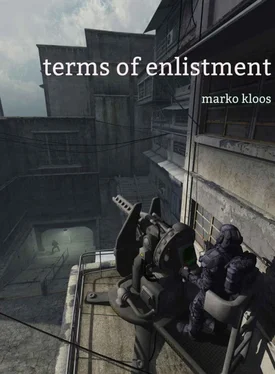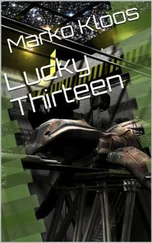I stuff the pistol back into the harness, and shoulder the MARS. The machine gunner in the distance has switched to very short bursts, two or three shots at a time, undoubtedly to preserve ammo while making us keep our heads down. My TacLink display shows Hansen moving further into the hallway to my left, and the rest of the squad huddled in a side alley thirty yards ahead. More than half their number are out of the fight, according to the symbols on my screen.
The operation of the MARS launcher is dead simple. We’ve drilled the deployment of the MARS a dozen times, and for some odd reason, I hear Sergeant Burke’s voice in its unforgettable drill instructor twang as my fingers perform the necessary steps to ready the launcher for action.
I point the center of the reticle at the muzzle flashes of the heavy machine gun in the distance, near the top floor of the high rise a third of a mile away, and pull the trigger.
The rocket leaps out of its launch canister with shocking speed. The tail end of the rocket glows with the heat of its internal booster, and the whole thing shoots off into the distance only a little slower than a tracer round. I expected to see the rocket leisurely rise skyward like the Sarissas we used back at the embassy a few weeks ago, but the MARS streaks downrange in a blink, covering the distance between us and the machine gun position in just a few seconds.
My aim was a bit off. The rocket hits the building two floors below the machine gun that is still spitting tracers our way. There’s a bright flash that cuts through the hazy night sky, and then the thunderclap of the explosion rolls across the PRC.
When I grabbed the rocket launcher, I took a high explosive and a thermobaric warhead out of the rack, and loaded one of them into the launcher to be less encumbered. The one I loaded was the thermobaric missile.
The MARS launcher fires ninety-millimeter rockets. It’s designed to take out enemy fortifications and reinforced structures. A high-rise tenement is a very light structure. It’s a steel skeleton with thin modular concrete sheets for walls.
The missile hit twenty feet below the window with the heavy machine gun, but the bunker buster warhead is rather forgiving of aiming errors. The front of the floor around the impact point erupts outward, windows and walls turned into millions of bits and shards by the overpressure. The explosion is much more dramatic than the one caused by the thermobaric rifle grenade I fired into the building with the sniper during the embassy evacuation. Over by the high rise, the sky is filled with flaming debris as the pressure of the explosion radiates outward. Then the entire front of the building above the point of impact collapses with the tortured groan of fatigued metal and concrete. I watch in morbid fascination as the four or five floors above the explosion pancake into each other. More concrete slides off the face of the building, this time in bigger chunks. When the rumbling stops, there’s a dust cloud above the high rise that reaches hundreds of feet into the sky. The side of the building that’s facing us now has a massive wound in its upper half, a smoking gash that’s five floors high and three quarters of a floor wide.
Part of me realizes that I just blew up twenty apartments, with everything and everyone within. Mostly, however, I am just glad that the heavy machine gun has stopped raining death onto my squad.
I get down on one knee and work the fastener for the now-empty cartridge husk at the rear of the launcher. As I drop the expended hull and pick up the second cartridge, someone starts shooting from the rooftop across the street again. I feel something hitting the side of my armor right underneath my arm. The impact is hard enough to make me drop the launcher tube in surprise. Hansen’s rifle is half a foot to my right, and I scoop it up and work the bolt. The grenade launcher is empty, but the magazine is still half full.
The shooter on the roof is a woman. She’s dressed in baggy and shapeless clothes, but I can clearly see her long hair, and her feminine features underneath the bill of the cap she is wearing. She’s down on one knee, right by the edge of the roof, and she’s holding a rifle with a wooden stock. As I watch, she works a lever at the bottom of her rifle to load another round into the chamber. She performs the motion without taking the weapon off her shoulder, and her eyes never waver from the sights.
I stare at her, this woman that looks like a dozen I’ve known back home, just a hood rat in too-big clothes, and I want to wave her off, shout a warning, or both—anything to keep her from shooting at me, so I won’t have to shoot her in turn. Then she pulls the trigger on her rifle.
The bullet hits me right above the eyebrow, on the ridge that forms the upper edge of the face shield. It feels like being beaned with a well-thrown fastball. I stumble backwards and fall on my ass. My helmet display blanks out momentarily from the shock of the impact.
This was a killing shot that just barely missed. She shot at my armor to get my attention and make me turn around, and the second shot was aimed right at my visor, the weakest point of my battle armor. My sensors restore my low-light vision just in time for me to see the woman on the roof complete another stroke of the loading lever on that antique rifle of hers. My right hand is still wrapped around the grip of Hansen’s rifle, and unlike my opponent, I don’t have to bring my rifle up into my field of vision to aim it.
We pull our triggers at the same time. Her bullet cracks into my visor, right at the seam between the clear face shield and the reinforced ballistic shell of the outer helmet. It’s another near miss, but an improvement over the last one. I feel a sharp jab of pain right underneath my left eye that radiates out to my ear, as if someone had sliced the side of my head with a sharp knife.
My rifle sends not just one, but half a dozen rounds in return. They hit the woman on the roof dead center in the chest, the perfect aim of a computer. She doesn’t cry out or flinch. Instead, she just falls forward, and there’s nothing between her and the street below to break her fall.
From the way she falls, limbs flailing without any semblance of control or coordination, I know that she is already dead when she hits the ground. Still, I feel the urge to run the twenty yards to where she is now splayed out motionless on the dirty asphalt.
I seize her by the collar of her jacket and turn her around to get a look at her face. Her eyes are open, but unfocused in death. There’s no pain in her face, no surprise or distress. She looks about thirty, maybe a few years younger. Her ball cap fell off her head when she fell off the roof, and her hair is held together in a loose ponytail. I can’t tell the exact color of it with my augmented night vision, but it’s dark hair, brown or auburn.
“Grayson, if you’re still standing, get your ass over here,” I hear over the squad channel, the first time someone has used the voice network since the machine gun opened fire. The identifier tag on my helmet screen marks the speaker as Corporal Jackson, but she sounds odd, like she’s speaking slowly through clenched teeth.
“Copy,” I respond, and check her location on the map. The bullet that pierced the side of my visor missed the monocle of the data computer, and I still have a data feed in my field of vision. The left side of my face feels like it has been worked over with broken glass. I can feel warm blood trickling down my cheek.
The squad is huddled together in the alley ahead and to my left. I reload Hansen’s rifle with a fresh magazine.
“Hansen, do you copy?” I ask into the squad channel.
“Yeah, I’m here,” Hansen replies. “I’m at the end of the entrance hallway, right before the bend. Mind your trigger finger when you come in.”
Читать дальше












